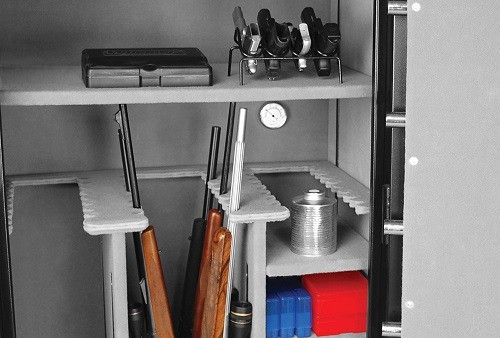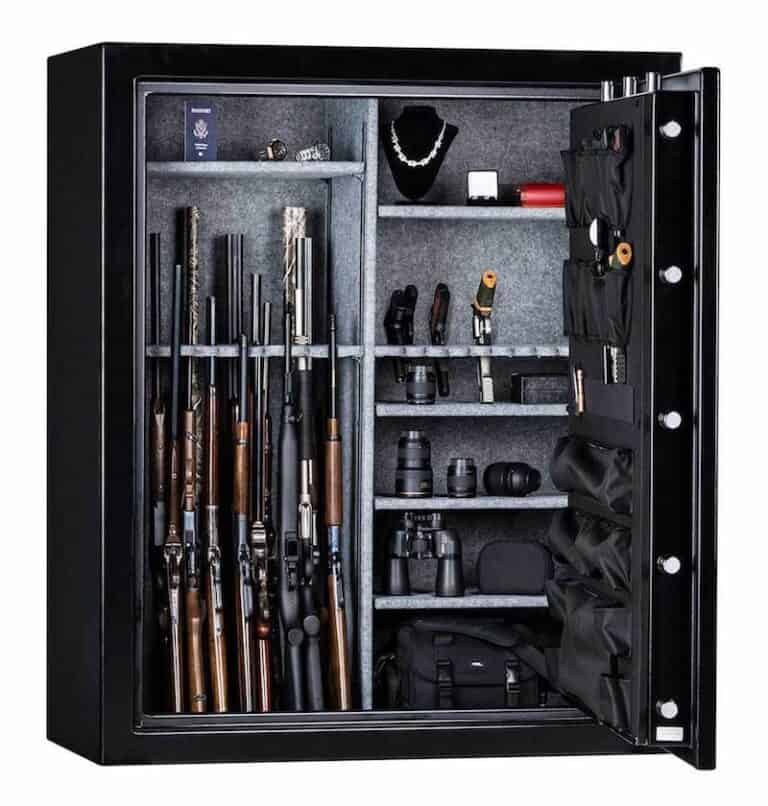The word “airtight” gets thrown around quite frequently, in regards to various gun safes on the market. Many feel that their gun safes are completely airtight, or extremely close to the like.
Those that express these thoughts also tend to tout the virtues of an airtight gun safe, and all the potential benefits associated with it.
However, can a gun safe truly ever be airtight, and if so, what advantage does this offer? For the sake of discussion, is there any true value in an airtight gun safe, if such a thing were to exist.
Below, we explore this notion, by determining whether or not airtight gun safes actually exist. We will also discuss the effects that airflow has upon the contents of a gun safe, over the course of several years.
Table Of Contents
Why Is Airflow A Bad Thing?

So why is it worth pondering whether or not a gun safe is airtight? Quite simply, the contents of a safe, kept in an airtight space, would not be subject to the same environmental factors as that which is exposed to open air.
In essence, firearms and ammo kept within an airtight space would remain in their current state, unaged, for a lengthy period of time. This, of course, would be dependent upon any air within a safe being dehumidified to the extent of preventing condensation.
In theory, an airtight gun safe would prevent firearms from being exposed to high levels of atmospheric moisture. Air naturally contains a certain level of moisture, which varies on behalf of several factors.
As the humidity level rises, so does the amount of moisture content that is present in the air.
This water can actually condense within a gun safe, upon reaching the air’s natural dew point. Water is then deposited upon the contents of a safe, including any firearms contained within.
The open flow of air into a gun safe allows this cycle to repeat itself, time and time again.
Much like any object composed primarily of metal, guns are subject to corrosion (rust), at the hands of moisture. With time, excessive moisture can cause unsightly pitting of a gun’s metal surfaces.
Additionally, deposited moisture can cause mildew to set up within the fabric liner contained with a safe.
The open flow of air into a gun safe also poses another potential issue. Oxygen, contained within the air, is instrumental in a fire’s ability to burn and spread.
Therefore, the open circulation of air into and through a gun safe poses an additional risk, in the event that a house fire was to break out.
On the contrary, in theory, an airtight gun safe would be extremely fireproof, as fire would be incapable of penetrating the safe’s shell. Additionally, little oxygen would exist within a safe of this type, thereby limiting the content’s combustibility.
Though the idea of a 100-percent fireproof safe is more or less a work of fiction, any model of an airtight design would possess a fire rating far in excess of the industry standard.
Does An “Airtight” Gun Safe Exist
The Webster Dictionary defines the word airtight as follows:
Impermeable to air, or nearly so
Essentially, the word “airtight” describes something sealed so tightly, that no air is allowed to enter or escape. However, the question remains.
Is there a gun safe on the market today that fits the textbook definition of airtight?
The short answer to this question is “No”. There are not currently any gun safes on the market that could be considered 100-percent air-tight.
This is because it is essentially impossible to seal such a large area, especially considering the size of a safe’s door, which must also remain free of air leaks when closed.
Even today’s best gun safes, of the most heavy-duty construction, prove incapable of preventing all air intrusion. Perhaps the most significant entry point for incoming air is around the safe door seal or gasket.
In most safes, this gasket amounts to little more than a rubberized strip, which compresses against the safe’s door frame, when the door itself is closed.
However, gaskets of this type are far from perfect and are completely incapable of stopping all incoming air. A complete seal of this gasket is improbable, as the two pieces of metal that it is sandwiched between are in no way torqued together.
Air also enters a gun safe through the area around a lock’s keypad, the safe’s mounting holes, and through pre-drilled access holes, where wiring is intended to be run. Though the amount of airflow permitted into most high-end gun safes is quite minimal, it is certainly enough to prevent an airtight rating.
Can A Gun Safe Be Made Airtight?
This naturally leaves one to question whether or not their existing safe can be modified to create an airtight effect. In truth, it can be nearly impossible to render a gun safe completely airtight.
However, with a few minor tweaks, one can greatly reduce the amount of moisture within their gun safe.
Rather than attempting to make a gun safe airtight, gun owners should focus on controlling the state of the air that naturally circulates through such a confined space. The single most effective way of accomplishing this is through the use of a safe dehumidifier.

An electric dehumidifier, of any type, greatly reduces the amount of atmospheric moisture within a given space. In this instance, a dehumidifier is being used to prevent sweating and condensation within the confines of a safe, thereby reducing the buildup of moisture.
Alternatively, some gun owners choose to place silica gel desiccant pouches throughout their safes. These rechargeable pouches naturally absorb airborne moisture, thereby minimizing the amount of water that is deposited upon the contents of the safe.
In some cases, desiccant products can be used in conjunction with a dehumidifier, which provides a second barrier of protection.
Many also employ the use of a goldenrod within their gun safes, in a bid to keep rust and other forms of corrosion at bay. A goldenrod is a specialty heating element that warms the air within an enclosed space to several degrees above ambient temperature.
This prevents condensation and creates a much more hospitable environment for firearms to be stored.
Those looking to minimize water intrusion might also consider elevating their gun safe, if it is to be positioned on a concrete floor. Concrete is known to absorb and release moisture over a period of time, which in turn, presents a damp environment.
This moisture can be readily transferred to a gun safe when stored directly on top of a concrete surface. To avoid this scenario, wooden slats can be placed beneath a gun safe, effectively eliminating its contact with the concrete below.
Protecting Your Investment
At the current moment, the notion of an airtight gun safe simply equates to wishful thinking. However, even if a safe of this nature did exist, its advantages over current top-tier safes would be quite limited.
While an airtight gun safe might present a few less issues relating to moisture intrusion, and carry a slightly higher rating in regards to fireproofing, such benefits would be minimal.
Today’s premium biometric gun safes prove more than secure enough to deter the average burglar and are sealed tightly enough to minimize the bulk of issues pertaining to moisture intrusion. Any remaining moisture can be easily controlled with the use of a few simple countermeasures, leaving the contents of your safe free from harm’s way.
With a little care, your stash of long guns and handguns will remain in pristine condition for decades to come, even in absence of airtight storage.
